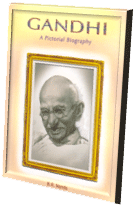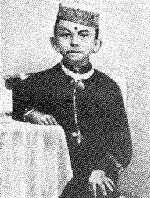
P.O. SEVAGRAM, DIST.WARDHA 442102, MS, INDIA. Phone: 91-7152-284753
FOUNDED BY MAHATMA GANDHI IN 1936
BIOGRAPHY OF GANDHI
GANDHI - A PICTORIAL BIOGRAPHY
by Shri B. R. Nanda

GANDHI
- A PICTORIAL BIOGRAPHY
Shri B. R. Nanda
Table of Contents
- About Gandhi
- Childhood
- Off To England
- Briefless Barrister
- In The 'Dark Continent'
- The Young Politician
- Satyagraha Struggle In South Africa
- The Making Of The Mahatma
- Return To India
- Gandhi's Ashram
- World War I
- Rowlatt Bills
- Nonviolent Non-cooperation
- Arrest And Imprisonment
- Reaction And Recovery
- Declaration Of Complete Independence
- Gandhi-Irwin Pact
- Round Table Conference
- In London
- Resumption Of Struggle
- Campaign Against Untouchability
- A New Deal For The Village
- The New Constitution
- Hindu-Muslim Antagonism
- Nonviolence In A Violent World
- Cripps Mission
- "Quit India"
- Simla Conference
- Cabinet Mission
- Communal Conflagration
- Partition of India
- Mission of Peace
- The End
- Gandhi and Nonviolence
About This Book
This is the first pictorial biography of Gandhi in which the narrative-concise, readable and incisive is illustrated with contemporary photographs and facsimiles of letters, newspaper reports and cartoons, adding up to a fascinating flash-back on the life of Mahatma Gandhi and the struggle for Indian freedom led by him. There is a skilful matching in this book of text and illustrations, of description and analysis and of concrete detail and large perspective. This pictorial biography will revive many memories in those who have lived through the Gandhian era; it should also be of interest to the post-independence generation.
About Author
Shri B. R. Nanda - former Director, Nehru Memorial Museum and Library, New Delhi. His full-scale biography of Mahatma Gandhi has been published in India, Britain and the U.S.A. and translated into French, Spanish, Italian and several other languages
Chapter-6 : Satyagraha Struggle In South Africa

It was the passage of the Asiatic Registration Act in Transvaal in 1907 which convinced Gandhi that the method of protest, petition and prayer which he had sedulously pursued for nearly fourteen years had failed. It was at this juncture that he evolved a new technique, which came to be known as Passive Resistance; but as it ruled out both verbal and physical violence, it differed in important respects from the campaign waged on behalf of the suffragettes in England. The principles and techniques of Gandhi's movement were to evolve gradually in the ensuing months ant years; its author was a man for whom theory was the handmaid of action.
It is not possible here to give a detailed account of the Satyagraha struggle which Gandhi led in South Africa for seven years. It required great courage, patience and organizing ability to persuade the small Indian community to pit itself against the government. Gandhi had to reckon with the immense political and economic power wielded by the dominant European community, the stubbornness of the local government in South Africa, the reluctance of the British Colonial Office to antagonize the Union Government in Pretoria, the apathy of the Government of India and the limited resources of the small India minority fighting for its survival on an alien soil. Gandhi himself worked under terrific pressure. In January 1908, he was arrested for breach of the registration law and clapped into prison. The following month he was released after an understanding seemed to have been reached with the government. A few days later, he was beaten up and severely injured by a compatriot, who accused him of betraying the Indian cause.
The truce with the Transvaal Government did not last long. The Satyagraha campaign had to be renewed. There were acts of defiance by the Indians and punitive measures by the authorities. Gandhi set up a small colony-Tolstoy Farm- at an 1100 acre site, 21 miles from Johannesburg where his colleagues in the Satyagraha struggle and their families could support a frugal and hard existence- which was in fact harder than life in jail-by-running a cooperative farm. "We had all become labourers," Gandhi recalled later, "put on laborer's dress, but in the European style, viz., Workman's trousers and shirts which were imitated from prisoner's uniform". Those who went to Johannesburg on private errands had to walk. Gandhi himself, though past forty and living only on fruits, did not think much of walking forty miles a day; he once did 55 miles without feeling any the worse for it. All residents of Tolstoy Farm including children had their quota of manual labour. Those who had known this austere discipline could have little fear of goal.
In1912, Gokhale, one of the most eminent Indian politicians of the day, paid a visit to South Africa and discussed the problems of the Indian community with General Smuts and other members of the South African Government. He returned to India with the impression that the Asiatic Registration Act and the hated £ 3 tax on the ex-indentured labourers would be abolished. When this did not happen, and an additional provocation was given by Supreme Court Judgment invalidating marriages of non-Christians in South Africa, Gandhi launched what turned out to be the final phase of his struggle in South Africa.
A party of eleven Indian women, including Gandhi's wife Kasturba, courted imprisonment by crossing from Natal into Transvaal without a permit. The Indian labourers in the coal mines at New Castle went on a sympathetic strike. The mine-owners retaliated by cutting off water and electric connection to the areas where the labourers lived. Gandhi had no option but to take charge of the miners and their families, 2037 men, 127 women and 57 children. He decided to walk them from New Castle to Tolstoy Farm, but was arrested on the way. In Volksrust jail he was make to dig stones and sweep the compound. Later he was transferred to Pretoria jail and lodged in a dark cell ten feet long and seven feet wine, which was lit up at night only to check up on the prisoner. He was denied a bench, refused permission to walk in the cell and subjected to numberless pinpricks. Summoned for evidence in a case, he was marched to the court with hand-cuffs on his hands and manacles on his feet. Meanwhile, the Indian labourers had been put into special trains, and taken back to New Castle mines where they were forced to go underground by mounted military police.
The 'blood and iron' policy of the South African Government stirred India deeply. Gokhale sent two earnest Christian young men, C.F. Andrews and Pearson, to assist Gandhi. Lord Hardinge, the viceroy of India, courageously denounced the high-handed policies of the South African Government. Negotiations began between Gandhi and the South African Government under pressure from Delhi and London. Eventually an agreement was reached. Some of the major points on which the Satyagraha struggle had been waged were conceded to the Indians. The tax on the ex-indentured labourers was abolished; marriages performed according to Indian rites were legalized, and a domicile certificate bearing the holder's thumb-imprint was too a sufficient evidence of the right to enter South Africa.
In 1939, a quarter of a century after the conclusion of the Satyagraha campaign, General Smuts, Gandhi's chief antagonist in South Africa, recalled: ' 'Gandhi himself received what no doubt he desired a short period of rest and quiet in goal. For him everything went according to plan. For me the defender of law and order - there was the usual trying situation, the odium of carrying out a law which had no strong public support, and finally the discomfiture when the law had to be repealed. For him it was a successful coup.''
In goal Gandhi had prepared a pair of sandals for General Smuts, who wrote that there was no hatred and personal ill-feeling, and when the fight was over, ''there was the atmosphere in which decent peace would be concluded''.